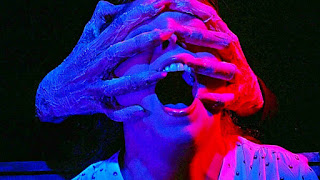(1981)
Overall: MEH
Boasting a compelling and bizarre premise, a wonderfully scene-chewing performance from Michael Ironside, and of course that dude's head blowing up, Scanners is still a slight misstep from David Cronenberg who otherwise was on a solid roll at the time. The most unmistakable drawback is the lead performance from Stephen Lack whose strange, unemotive line-readings seem consistently amatuerish and off-putting. It is also a problem that the actual character is poorly fleshed-out, which can be said about everyone else as well. With no one coming off as relatable on screen, (or in Lack's case, even convincing), the movie struggles to emotionally connect its story of underground groups of telepathic psychics. Again though, there are some nifty ideas here and memorable scenes, even besides the celebrated head explosion. Legendary make-up artist Dick Smith does his usual stellar work and the ending between Ironside and Lack both duking it out with their destructive brain powers is some wonderful body horror. Coming from Cronenberg, this is only natural yet also coming from Cronenberg, the rest of his 80s output was far stronger.
(1983)
Overall: GOOD
The only Stephen King adaptation from David Cronenberg, The Dead Zone represents one of the strongest cinematic entries for both director and author. Originally a Lorimar Film Entertainment production, the company ultimately went belly-up before the project could get off the ground, eventually getting in the hands of Dino De Laurentiis who went through a few screenwriters, (including King himself whose treatment of his own material was classified as "involved and convoluted"), before Cronenberg got on board. This was the first of his movies not to be written by him and perhaps because of that, it does not have the explicitly stated body horror elements of his usual work. Still, the source material does deal with awakened senses and this in effect produces at least a psychic morph with disturbing results. Christopher Walken delivers one of his strongest performances as a man both cursed and blessed with second sight who paid terribly for a "gift" that he hardly asked for. Martin Sheen is likewise excellent as a shady politician and he would play yet another creep in the following year's Firestarter, also from King.
(1988)
Overall: GREAT
After a steady stream of bizarre body horror excursions, David Cronenberg went introspective for the first time with Dead Ringers, one of his most artistically triumphant works. Based in part on the mysterious, real life deaths of gynecologist twins Stewart and Cyril Marcus as well as the book Twins by Bari Wood, the movie examines the complex, emotional dependency of such siblings whose personalities are markedly different yet become more and more interchangeable as their detachment succumbs to the traumatic. Jeremy Irons is utterly terrific in the dual lead, who never once exaggerates his performances in a gimmicky way. Instead, he portrays subtle yet clear contrasts in each twin's behavior and makes them both equally sympathetic even as their actions become self destructive and morally deplorable. The split screen special effects hold up quite well and Cronenberg indulges in very few gross-out gore moments, which grounds the still extreme subject matter appropriately. It is quite a stretch in fact to label this a horror film at all, certainly in a traditional sense even by the director's usual, challenging standards. Though it does deal with rather explicit and shocking events, the focus is purely psychological and it remains quite fascinating and fully realized.





















